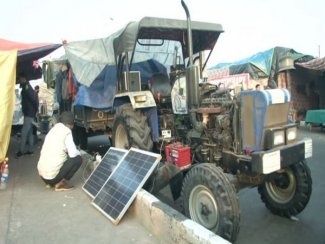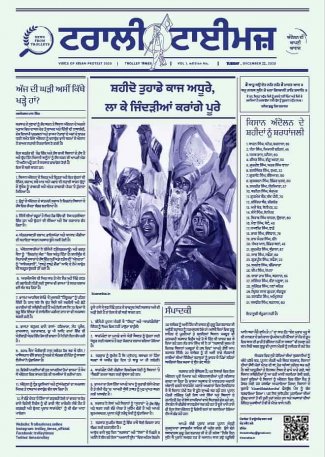What gives 70 and 80-year older adults as well as youngsters the strength and resilience to protest day after day, notwithstanding the bitterly cold days and nights, often in 36°F (3°C) temperatures? What has ignited the passions and strengthened the resolve not only of the protestors but the millions who are supporting, volunteering, and serving them? Why is this movement gaining momentum? How do you cater to and manage the day-to-day living needs of a quarter-million protestors?
The farmers’ protest in India is now in its sixth week. Estimates are that between 250,000 and 300,000 protesting farmers and their supporters have converged at various border points and laid a siege of sorts around New Delhi. Much of the news media and politicians are focused on the pros and cons of these farm acts and their political ramifications. But missing from these narratives is the strength of the human spirit, the passion, agility, and resilience of the people in an evolving movement running very efficiently – with no formal organization, no traditional structure, and no single leader or farmers union.
Also lost in these discussions is the significance of farming in Panjab. The way it is woven into the community’s cultural fabric and psyche. It is at the core of the stories passed down from generation to generation. The music, the festivals, the dancing, and life – all revolve around and are rooted in the farming seasons and traditions.
The protests provide some valuable lessons in “servant” leadership, organizational purpose, ingenuity and “frugal” innovation, community philanthropy, logistics, and the immense power of the human spirit.
What are these ongoing protests about? They are about three Farm Acts passed by the Indian parliament in September 2020. The government maintains that these three Farm Acts will streamline the farmers’ efforts to sell their produce directly to private buyers. However, the farmers and their unions maintain that these laws will gradually end the “mandi” system and minimum support price guarantees and leave them at the large corporates’ mercy and whims. The three Farm Acts were passed into law with wide-ranging ramifications for the country's economy without any consultations with or buy-in from the key stakeholders – particularly the farmers and the farmer unions.
“We will lose our lands; we will lose our income if you let the big business decide prices and buy crops. We don’t trust big business. Free markets work in countries with less corruption and more regulation. It can’t work for us here,” one farmer told the BBC last week.
How is this growing “virtual” organization functioning? Khalsa Aid, an international NGO, has shown incredible agility in setting up and organizing “Kisan Malls” at the Tikri and Singhu borders and a system for distributing daily essentials. These “Malls” provide toiletries and everyday essentials free of cost to the protesters – including toothbrushes, toothpaste, soap, shampoo, oil, combs, mufflers, heating pads, knee caps, thermal suits, shawls, and blankets. All this is being funded by the larger community’s generosity and is running by volunteers whose mission is to serve – and they are doing it with military precision that many organizations and corporations would envy.
Members of the Mansa Cyclist Group and ordinary citizens have provided hot water geysers, washing machines, generators, and truckloads of wood (to light fires for cooking and keeping warm) to the protest sites. Retired athletes are running a laundry service. Protesters are setting up schools on the pavements for underprivileged children and libraries to inspire and nurture minds. Solar panels are attached to tractors and trolleys for charging mobile phones and running washing machines. Sanitation, cleanliness, patrolling the streets is being managed by the youth as well as the farmers. Medical and dental clinics staffed by volunteer doctors have sprung up all over the border area. It seems like everyone is aware of their “purpose” and believes that their presence and efforts can make a difference.
“Langar seva” (free food distribution and service) is in abundance, thanks to the nearby gurduaras, the volunteers as well as the farmers. Makeshift open-air kitchens have sprung up all over the border. Nearby villages are sending milk and fresh produce daily. Women are making food and “pinnis” (round ball-shaped sweets made from wheat flour, jaggery, and almonds – a quintessential winter snack) and sending them to the front lines of the protest. All this is happening with the humbling generosity of supporters who, along with the farmers, are fighting for social and economic justice. This is the epitome of “servant” leadership and volunteerism. Each one of these volunteers is a grassroots leader – leading the movement towards a common purpose.
“Trolley Times,” a newsletter from the protest site headquarters in Tikri, has emerged at the Delhi-Haryana Border, founded by a doctor, a dentist, a brother, and sister – to voice the farmers’ movement, their struggles and counter the government and mainstream media maligning and misrepresenting the farmer’s struggles. The team includes a film writer, a video director, two documentary photographers, and a farmer. The paper began in Panjabi and Hindi; an English edition has been added. The protesters are the translators, the photographers, and the printing press operators.
The eighty-year-old iconic Indian photo-journalist, Raghu Rai, who has been documenting the country’s history for the last fifty-five years, was spotted at the Singhu border, capturing the sights of the protest. He said, “For the last thirty-odd years, globalization has changed our clothes, our looks, the way we speak and act and our way of life to Western influences. As I look around, I see farmers from Panjab, Haryana, Rajasthan, and the Khalsas all sitting together with love and respect. That Bharat that I thought we had lost to globalization is alive and well at this protest. I have never witnessed anything like this in any of the other protests that I have covered in my lifetime.”
And the women? Thousands of women have joined the army of protesters, and their numbers have started to swell – students, teachers, nurses, homemakers, grandmothers. They are not just cooking “rotis” in the background but are at the front lines actively participating on the stage, addressing the crowds, organizing, and being present at the daily briefings. Women farmers like Sunita Rani from Haryana have been at the protest since the beginning. She said, “women are never counted as farmers ... We are always counted as housewives, but not farmers. I am here to change that perception.” They are the “invisible” workforce, and they are hoping to protect their livelihoods, change perceptions, and gain due recognition as farmers. Many are well-educated daughters of farmers and are social media savvy. They want to be at the front lines and are giving the movement a new dimension. Their tenacity has defied the common perception of the docile rural woman.
The protests have been mostly peaceful, with no reported crimes or violent clashes despite the government censoring and jamming signals and banning all social media from the protest sites.
Regardless of the outcome, the Indian farmers’ movement has taught us much about the essence of service and servant leadership, organization and purpose, agility and ingenuity, and community philanthropy. The movement has ignited a passion and raised the people’s consciousness of the farmers’ economic plight and hardships. It has touched a deeper chord among the masses than the government would care to admit. This movement’s social ramifications are far more significant than just calling it a “kisan andolan” (the farmers’ protest). Movements offer a new and different language of justice, political engagement methodology, and revisions of social contracts. Whether this Movement receives “real world” media attention or not, the Farmers have won. This is healthy citizen empowerment in the face of “extremely sophisticated opponents.” The “kisan andolan” has become far more prominent than a protest or movement – one could consider it a “social revolution.”
Despite everything India has been through this year with the pandemic, the human values and indomitable spirit are very much alive.
~~~~~~~~~~~~~~~~~~~~~~~~~~~~
Inni Kaur is the Creative Director at the Sikh Research Institute (SikhRI). She is a passionate author, poet, and painter. Inni Kaur is a frequent speaker at community and interfaith events, the U.S. Office of the Pentagon Chaplin, and Yale, Fairfield, Columbia, and other universities. View her published works and art at www.innikaur.com
Ravi Singh Dhingra is Adjunct Professor of Management at Sacred Heart University and President at Spectrum Marketing Communications Inc. He has held senior management and marketing roles in the U.S., Europe, Australia/New Zealand, and Asia – developing new brands, building and managing businesses at Bristol-Myers Squibb, Procter & Gamble, and Spectrum Communications. He has an MBA in international business and marketing from the Wharton School, University of Pennsylvania, and a Master’s in Management Studies from the University of Bombay.










